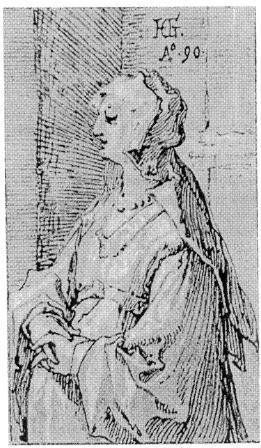In a letter dated 5 May 2005, Arthur Feldmann’s grandchildren requested the restitution of a sketch by Hendrick Goltzius entitled Woman standing with veil. The sketch was executed with brush and brown ink on the back of a playing card (seven of hearts). At the time the claim was submitted, the work was in the Rijksmuseum / National Print Collection. The sketch was not part of the Netherlands Art Property Collection of recovered works but was bought by the Rijksmuseum in 1949 and hence became part of the National Art Collection.
A special feature of this case was the discovery that the claimed sketch had been looted by the Nazis during the occupation of what is today the Czech Republic, after the invasion of German troops on 15 March 1939. Arthur Feldmann, of Jewish extraction, lived with his wife in Brno in Czechoslovakia, where he worked as a lawyer and businessman. He was a renowned art lover, specialising in building a collection of sketches by Old Masters, which he kept at his house. The collection comprised approximately 750 works. The Gestapo confiscated Feldmann’s villa immediately after the invasion. Feldmann’s license to practise law was revoked and his assets frozen. In 1941, he was arrested, tortured and sentenced to death. After suffering a stroke, he was released but died a few days later. His wife died in Auschwitz in 1942. Both sons and their wives managed to escape to Palestine.
Although it was not possible to ascertain exactly what happened to the collection of sketches, including the claimed work, during the occupation, the Committee considered it sufficiently plausible that the collection had been confiscated by the Gestapo, thus also confirming the involuntary loss of possession, a condition for restitution. Archive material from the period after the war was still available and it was found that part of the Feldmann collection, including the sketch by Goltzius, had been put up for auction in London by an anonymous seller in February 1946, where it was purchased by a London art dealer who later sold it to the Rijksmuseum, thereby becoming part of the National Art Collection.
In a meeting held on 15 May 2006, the Committee recommended that the sketch be returned to Feldmann’s heirs, now that all conditions for restitution had been met. On 3 November 2006, in accordance with the recommendation, the Minister decided to return the work, albeit on slightly differing grounds.
